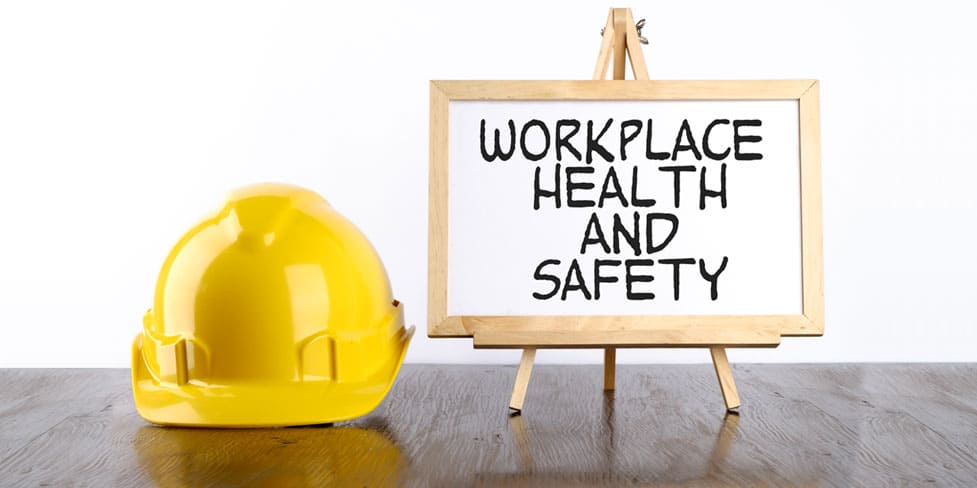Adhering to UK health and safety requirements is one of the many responsibilities of UK company directors and business owners. In this blog, we discuss what this entails and how to ensure your business is legally compliant in this department with our 5 top tips on health and safety at work.
- Our Privacy Package – keeping your home address private
- Take the stress out of filing deadlines with our Confirmation Statement Service
- A professional company secretary to take care of your business
- What are the filing requirements of a limited company?
The Health and Safety at Work Act 1974
The primary piece of health and safety legislation you need to be aware of is the Health and Safety at Work Act 1974. This is a fairly broad piece of legislation that sets out a list of basic health and safety requirements that UK businesses must fulfil.
Above all else, the Act mandates that all employers must protect the health, safety, and welfare of all employees, casual workers, self-employed individuals, clients, visitors, and any members of the general public present on business premises.
The Health and Safety at Work Act 1974 applies to most businesses in the UK, even sole traders and other self-employed individuals. There are certain types of self employment that are exempt from health and safety requirements, as long as the individual and their work activities do not pose any sort of potential risk to the public.
According to the UK Government’s Health and Safety Executive (HSE), exemptions are often made for novelists, journalists, graphic designers, accountants, and financial advisors. But there is no hard and fast rule.
When in doubt and wherever possible, assume that your business is required to comply with HSE safety laws. Not only does it demonstrate a commitment to best practice, but it shows your customers, clients, and other members of the public that your business cares about its community and the individuals that inhabit it.
More important still, it’s worth pointing out that the UK’s workplace health and safety requirements are in place to protect you and your company from harm. It is in everybody’s interest, including yours, to comply.
What does your company need to do to manage health and safety requirements?
Fortunately, managing health and safety obligations and ensuring that you are compliant with existing legislation is fairly simple and affordable. It doesn’t even require a major time commitment. All you need to do is carry out a few recurring tasks. The amount of time and energy you need to devote to those tasks depends entirely upon the size of your business and what it does.
To make sure your business is staying on top of health and safety requirements, you should follow the five easy tips below.
1. Appoint a designated health and safety officer
One of the first steps after registering a business is to appoint a designated team member to manage all health and safety activities (which we’ll outline in just a minute).
If you run a small company that is a low-risk business in terms of health and safety, you’ll normally find that you can quite happily appoint an existing employee to take on these tasks without adding a whole lot to that person’s workload.
That being said, if your company is bigger, or the activities your company carries out are particularly high-risk (such as operating fairground attractions, planning large events, or doing construction work) you may find that you need to hire a full-time member of staff with the correct skills, knowledge, and experience to manage health and safety requirements.
If you’re unsure about how big an undertaking health and safety management could be for your limited company, or you’re not sure what type of individual you should be appointing, advice and guidance is available from the Health and Safety Executive (HSE).
2. Create a health and safety policy
It’s all well and good appointing somebody to oversee your company’s health and safety requirements, but you should also have a written policy.
Drafting a health and safety policy for your company is an incredibly important step in mitigating any potential risks. It will keep your designated health and safety officer strategically focused, and you can share it with staff to ensure that everyone is aware of your commitment to health and safety. More importantly, they will know what is expected of them in terms of behaviour, processes, and reporting potential risks or incidents.
Although the idea of writing a health and safety policy may sound quite daunting, it doesn’t need to be long or complicated. All you really need is a short spreadsheet or document that details who is responsible for what activity, when it gets done, and how it is completed.
If you need help, the HSE has many examples and templates of health and safety policies you can use. Conveniently, some of these even include a section for risk assessments, which we’ll get to next.
If you are bound to comply with the Health and Safety at Work Act 1974 but have less than five employees, you don’t technically need to write down your health and safety policy. That being said, it’s usually a lot easier to stay on top of health and safety requirements if you write down your policy and store it somewhere it can be referenced at short notice.
3. Conduct a risk assessment
A crucial element of your company’s health and safety compliance will be to carry out a detailed workplace risk assessment.
A risk assessment is a comprehensive exercise in which your company must identify any potential risks to health and safety in the workplace, then develop and implement control measures to mitigate those identified risks. Depending on the types of risks you identify, your company may be bound to implement particular measures in line with legislation.
Generally speaking, carrying out a risk assessment in the workplace can be quick, simple, and virtually cost-free.
The first steps
The first step in conducting a risk assessment is to identify all hazards. You need to turn your premises upside down and think about what activities, processes, or substances used could injure or harm employees, customers, or any other members of the public. A shortcut is to check all of the manufacturers’ instructions or data sheets for equipment and chemicals, look back through your company’s accident records to identify recurring themes, and consider non-routine operations like maintenance or cleaning operations.
- What records do limited companies need to keep?
- A registered office address with same-day digital mail service
- Did you know? You don’t need an accountant to file accounts if your company is not trading
- Director Appointment & Resignation Service
After you’ve identified and recorded potential risks, you need to decide who might be harmed by those risks and how. Think about how individuals could come into contact with risks and how they could be adversely affected. When carrying out this step, bear in mind that some workers may have particular requirements that may mean they could be impacted by certain risks in different ways.
Evaluate the risks
Next, you need to evaluate those risks and choose precautions that your company can (and will) take to mitigate them. You are legally bound to do everything that is “reasonably practical” to mitigate risks for the purposes of promoting health and safety in the workplace. This means that it is placed at your discretion to decide how much money, time, or effort you’re able to devote to mitigating identified risks.
You aren’t legally obligated to take actions that could be considered grossly disproportionate to the level of risk. But you do owe it to your employees, customers, and members of the public to keep everyone out of harm’s way. For example, if you’ve got a dangerously sharp corner on-site, you don’t need to change vehicle routes. Yet, placing a mirror on the corner to help prevent accidents would be an affordable and reasonable step to mitigate potential risk.
Another crucial point to bear in mind is that you are only going to be expected to include risks within your risk assessment that you, as the owner of the business, could be reasonably expected to know about. You can’t be held liable for a lack of planning surrounding unforeseeable risks.
Above all else, it’s important to get your team involved in the risk assessment to allow them to voice their concerns and bring attention to any hazards or potential risks they encounter. Often, these may be things that you are unaware of.
Record your findings and mitigating action
Next, be sure to record all your findings and proposed mitigation processes. Just like your company’s health and safety policy, you are not legally required to write down your risk assessment if your business employs less than five people. That being said, it’s incredibly useful to record your risk assessment – and it doesn’t need to take a lot of time.
Remember that your risk assessment should demonstrate that:
- You made proper checks where appropriate
- You have talked to those affected
- You have addressed all significant hazards
- You have taken reasonable precautions, and the remaining risk is low
- You have involved your team members as part of your risk assessment
Again, the HSE has a risk assessment template you can use to quickly create a comprehensive and organised risk assessment.
Finally, do not forget that a risk assessment will need to be updated as your business changes. New risks could emerge, so you should set time aside to review your risk assessment records on a regular basis to ensure everything is up-to-date.
4. Train your staff
Involving staff is a crucial aspect of health and safety management. In addition to consulting your team on potential hazards, risks, and mitigation, you must communicate with staff and provide training on the precautions you have made. Every relevant employee must know how risks are controlled within the business and what information or training they need to stay safe and healthy.
That means you need to provide regular training sessions to make sure that all employees understand what is expected of them and how to identify hazards. Keep training records to ensure that all staff members have been trained. This will also help you to determine when refresher training is required.
Government advice on health and safety training indicates that, as a business owner, you are expected to provide training that is proportionate to the level of risk. In many cases, providing a list of simple operation instructions is all you’ve got to do.
It’s important to note that health and safety training is supposed to take place during working hours. You cannot charge your employees to undergo health and safety training. It must be provided by the company, regardless of whether you carry out training in-house or bring in an external agency.
If you’re not sure where to get started on educating your staff on health and safety requirements and training, the HSE provides a brief guide to health and safety training.
5. Get insurance
If you employ anyone to whom you are not related, then you are legally obligated to take out employer’s liability insurance. This insurance will protect you if someone gets sick or injured while working for your company. In accordance with UK law, your employer’s liability insurance must cover your business for at least £5m, and it needs to come from an authorised insurer.
Only a few businesses are not required to have employers’ liability insurance. If you have no employees or are a family business and all employees are closely related to you, you may not need it. By and large, however, it’s a good product to have, regardless of whether or not you’re legally obligated.
If one of your employees gets injured or becomes ill as a result of the work they are carrying out for you, they can claim compensation. That being said, as long as you have taken reasonable steps to prevent accidents or harm to your employees (and the injury or illness was caused after 1 October 2013), you should not have to pay any compensation. If a court does find you liable, employers’ liability insurance will then help you to pay any compensation due.
If you’re employing people and you are found to be trading without employer’s liability insurance, you can be fined up to £2,500 for each day that you are not properly insured. The UK Government can also fine you a further £1,000 if you choose not to display your employer’s liability certificate, or if you refuse to make your insurance documents available to any inspectors if and when they ask to see those documents.
The bottom line
Managing health and safety requirements might sound like a complicated and expensive process, but identifying and mitigating workplace hazards can be quick and affordable. It’s in your company’s best interest to ensure that everyone is kept safe and healthy at all times – and it is critical to your corporate image that your business is seen to be doing its part in protecting the community.
That’s why you owe it to your business to demonstrate best practice where health and safety is concerned. Once you get started, it should quickly become second nature. By appointing a designated person to oversee health and safety requirements, drafting a policy, carrying out a risk assessment, and conducting staff training, you should largely meet your company’s compliance obligations. Don’t forget to take out insurance, either.
Regulations are constantly changing, and the laws that apply to you and your business may vary based on the type of work you’re carrying out and the conditions you have to operate in. That’s why you need to stay on top of all relevant legislation. When in doubt, do not be afraid to seek professional advice.
Nothing is more important than preserving the health and safety of your customers, employees, and other members of the public. By mitigating those risks, you’ll be able to focus on making your business a success.
If you are looking for more information about running your limited company, it’s worth checking out our 1st Formations Blog. There, you’ll find detailed information on company tax, marketing your business, funding tips, and much more.
Please note that the information provided in this article is for general informational purposes only and does not constitute legal, tax, or professional advice. While our aim is that the content is accurate and up to date, it should not be relied upon as a substitute for tailored advice from qualified professionals. We strongly recommend that you seek independent legal and tax advice specific to your circumstances before acting on any information contained in this article. We accept no responsibility or liability for any loss or damage that may result from your reliance on the information provided in this article. Use of the information contained in this article is entirely at your own risk.












Join The Discussion
Comments (2)
Under the circumstances and with what we are facing I found this piece to be particularly insightful.
We’re glad you found our article useful, Shayur.
Regards,
John